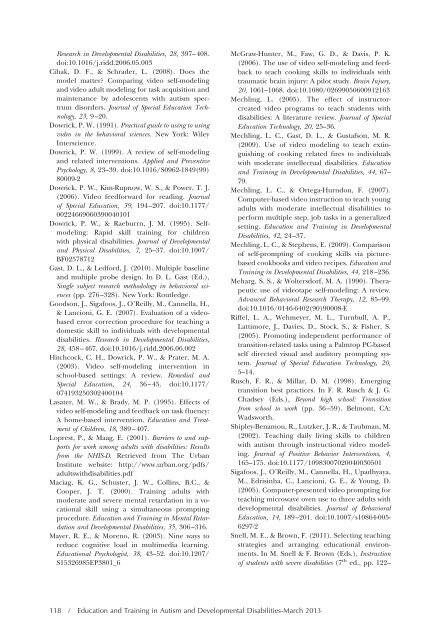etadd_48(1) - Division on Autism and Developmental Disabilities
etadd_48(1) - Division on Autism and Developmental Disabilities
etadd_48(1) - Division on Autism and Developmental Disabilities
You also want an ePaper? Increase the reach of your titles
YUMPU automatically turns print PDFs into web optimized ePapers that Google loves.
Research in <strong>Developmental</strong> <strong>Disabilities</strong>, 28, 397–408.<br />
doi:10.1016/j.ridd.2006.05.003<br />
Cihak, D. F., & Schrader, L. (2008). Does the<br />
model matter? Comparing video self-modeling<br />
<strong>and</strong> video adult modeling for task acquisiti<strong>on</strong> <strong>and</strong><br />
maintenance by adolescents with autism spectrum<br />
disorders. Journal of Special Educati<strong>on</strong> Technology,<br />
23, 9–20.<br />
Dowrick, P. W. (1991). Practical guide to using to using<br />
video in the behavioral sciences. New York: Wiley<br />
Interscience.<br />
Dowrick, P. W. (1999). A review of self-modeling<br />
<strong>and</strong> related interventi<strong>on</strong>s. Applied <strong>and</strong> Preventive<br />
Psychology, 8, 23–39. doi:10.1016/S0962-1849(99)<br />
80009-2<br />
Dowrick, P. W., Kim-Rupnow, W. S., & Power, T. J.<br />
(2006). Video feedforward for reading. Journal<br />
of Special Educati<strong>on</strong>, 39, 194–207. doi:10.1177/<br />
00224669060390040101<br />
Dowrick, P. W., & Raeburrn, J. M. (1995). Selfmodeling:<br />
Rapid skill training for children<br />
with physical disabilities. Journal of <strong>Developmental</strong><br />
<strong>and</strong> Physical <strong>Disabilities</strong>, 7, 25–37. doi:10.1007/<br />
BF02578712<br />
Gast, D. L., & Ledford, J. (2010). Multiple baseline<br />
<strong>and</strong> multiple probe design. In D. L. Gast (Ed.),<br />
Single subject research methodology in behavioral sciences<br />
(pp. 276–328). New York: Routledge.<br />
Goods<strong>on</strong>, J., Sigafoos, J., O’Reilly, M., Cannella, H.,<br />
& Lanci<strong>on</strong>i, G. E. (2007). Evaluati<strong>on</strong> of a videobased<br />
error correcti<strong>on</strong> procedure for teaching a<br />
domestic skill to individuals with developmental<br />
disabilities. Research in <strong>Developmental</strong> <strong>Disabilities</strong>,<br />
28, 458–467. doi:10.1016/j.ridd.2006.06.002<br />
Hitchcock, C. H., Dowrick, P. W., & Prater, M. A.<br />
(2003). Video self-modeling interventi<strong>on</strong> in<br />
school-based settings: A review. Remedial <strong>and</strong><br />
Special Educati<strong>on</strong>, 24, 36–45. doi:10.1177/<br />
074193250302400104<br />
Lasater, M. W., & Brady, M. P. (1995). Effects of<br />
video self-modeling <strong>and</strong> feedback <strong>on</strong> task fluency:<br />
A home-based interventi<strong>on</strong>. Educati<strong>on</strong> <strong>and</strong> Treatment<br />
of Children, 18, 389–407.<br />
Loprest, P., & Maag, E. (2001). Barriers to <strong>and</strong> supports<br />
for work am<strong>on</strong>g adults with disabilities: Results<br />
from the NHIS-D. Retrieved from The Urban<br />
Institute website: http://www.urban.org/pdfs/<br />
adultswithdisabilities.pdf<br />
Maciag, K. G., Schuster, J. W., Collins, B.C., &<br />
Cooper, J. T. (2000). Training adults with<br />
moderate <strong>and</strong> severe mental retardati<strong>on</strong> in a vocati<strong>on</strong>al<br />
skill using a simultaneous prompting<br />
procedure. Educati<strong>on</strong> <strong>and</strong> Training in Mental Retardati<strong>on</strong><br />
<strong>and</strong> <strong>Developmental</strong> <strong>Disabilities</strong>, 35, 306–316.<br />
Mayer, R. E., & Moreno, R. (2003). Nine ways to<br />
reduce cognitive load in multimedia learning.<br />
Educati<strong>on</strong>al Psychologist, 38, 43–52. doi:10.1207/<br />
S15326985EP3801_6<br />
McGraw-Hunter, M., Faw, G. D., & Davis, P. K.<br />
(2006). The use of video self-modeling <strong>and</strong> feedback<br />
to teach cooking skills to individuals with<br />
traumatic brain injury: A pilot study. Brain Injury,<br />
20, 1061–1068. doi:10.1080/02699050600912163<br />
Mechling, L. (2005). The effect of instructorcreated<br />
video programs to teach students with<br />
disabilities: A literature review. Journal of Special<br />
Educati<strong>on</strong> Technology, 20, 25–36.<br />
Mechling, L. C., Gast, D. L., & Gustafs<strong>on</strong>, M. R.<br />
(2009). Use of video modeling to teach extinguishing<br />
of cooking related fires to individuals<br />
with moderate intellectual disabilities. Educati<strong>on</strong><br />
<strong>and</strong> Training in <strong>Developmental</strong> <strong>Disabilities</strong>, 44, 67–<br />
79.<br />
Mechling, L. C., & Ortega-Hurnd<strong>on</strong>, F. (2007).<br />
Computer-based video instructi<strong>on</strong> to teach young<br />
adults with moderate intellectual disabilities to<br />
perform multiple step, job tasks in a generalized<br />
setting. Educati<strong>on</strong> <strong>and</strong> Training in <strong>Developmental</strong><br />
<strong>Disabilities</strong>, 42, 24–37.<br />
Mechling, L. C., & Stephens, E. (2009). Comparis<strong>on</strong><br />
of self-prompting of cooking skills via picturebased<br />
cookbooks <strong>and</strong> video recipes. Educati<strong>on</strong> <strong>and</strong><br />
Training in <strong>Developmental</strong> <strong>Disabilities</strong>, 44, 218–236.<br />
Meharg, S. S., & Woltersdorf, M. A. (1990). Therapeutic<br />
use of videotape self-modeling: A review.<br />
Advanced Behavioral Research Therapy, 12, 85–99.<br />
doi:10.1016/0146-6402(90)90008-E<br />
Riffel, L. A., Wehmeyer, M. L., Turnbull, A. P.,<br />
Lattimore, J., Davies, D., Stock, S., & Fisher, S.<br />
(2005). Promoting independent performance of<br />
transiti<strong>on</strong>-related tasks using a Palmtop PC-based<br />
self directed visual <strong>and</strong> auditory prompting system.<br />
Journal of Special Educati<strong>on</strong> Technology, 20,<br />
5–14.<br />
Rusch, F. R., & Millar, D. M. (1998). Emerging<br />
transiti<strong>on</strong> best practices. In F. R. Rusch & J. G.<br />
Chadsey (Eds.), Bey<strong>on</strong>d high school: Transiti<strong>on</strong><br />
from school to work (pp. 36–59). Belm<strong>on</strong>t, CA:<br />
Wadsworth.<br />
Shipley-Benamou, R., Lutzker, J. R., & Taubman, M.<br />
(2002). Teaching daily living skills to children<br />
with autism through instructi<strong>on</strong>al video modeling.<br />
Journal of Positive Behavior Interventi<strong>on</strong>s, 4,<br />
165–175. doi:10.1177/10983007020040030501<br />
Sigafoos, J., O’Reilly, M., Cannella, H., Upadhyaya,<br />
M., Edrisinha, C., Lanci<strong>on</strong>i, G. E., & Young, D.<br />
(2005). Computer-presented video prompting for<br />
teaching microwave oven use to three adults with<br />
developmental disabilities. Journal of Behavioral<br />
Educati<strong>on</strong>, 14, 189–201. doi:10.1007/s10864-005-<br />
6297-2<br />
Snell, M. E., & Brown, F. (2011). Selecting teaching<br />
strategies <strong>and</strong> arranging educati<strong>on</strong>al envir<strong>on</strong>ments.<br />
In M. Snell & F. Brown (Eds.), Instructi<strong>on</strong><br />
of students with severe disabilities (7 th ed., pp. 122–<br />
118 / Educati<strong>on</strong> <strong>and</strong> Training in <strong>Autism</strong> <strong>and</strong> <strong>Developmental</strong> <strong>Disabilities</strong>-March 2013
















